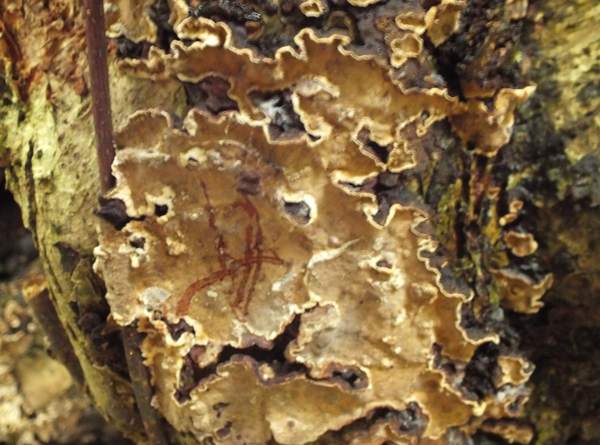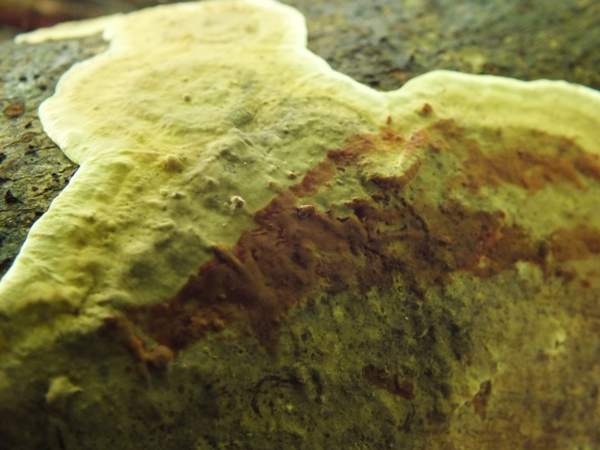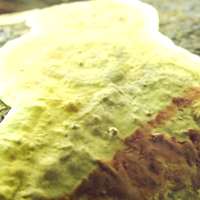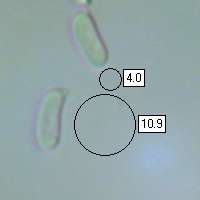Trees Birds Mammals Fish Amphibians Reptiles
Wild Algarve
Bookshop
Stereum rugosum (Pers.) Fr. - Bleeding Broadleaf Crust
Phylum: Basidiomycota - Class: Agaricomycetes - Order: Russulales - Family: Stereaceae
Distribution - Taxonomic History - Etymology - Identification - Culinary Notes - Reference Sources

Distinguished from most other crusts that occur on hardwoods by the characteristic of bleeding and remaining red when it has been scratched, Stereum rugosum is a very common but often overlooked crust fungus.
Distribution
Stereum rugosum is abundant and widespread throughout Britain and Ireland. On mainland Europe this wood-rotting crust fungus is found from Scandinavia right down to the Mediterranean region, and its range extends eastwards into Asia's temperate regions too. In North America this crust fungus is also very common.

Taxonomic history
This crust fungus was described in 1801 by Christiaan Hendrik Persoon, who gave it the scientific name Thelephora rugosa.
In 1838 Swedish mycologist Elias Magnus Fries transferred this species to the genus Stereum, and its scientific name, still generally accepted today, became Stereum rugosum.
Synonyms of Stereum rugosum include Thelephora rugosa Pers., Thelephora coryli (Pers.) Pers., Thelephora laurocerasi Berk., and Stereum stratosum Berk. & Broome.
Etymology
Stereum, the generic name, means tough, and crust fungi in this genus certainly can be difficult to tear when you want to take a small sample for investigation. The specific epithet rugosum refers to the fact that the fertile surface of this crust fungus becomes red (rugose) when scratched.
Identification guide
 |
Fruitbody
Entirely resupinate when young, sometimes becoming slightly detached at the edges when old; 1 to 3.5 mm thick; fertile surface may be either smooth or somewhat uneven; buff when young but paler at the edges, soon becoming ochre with a pinkish tinge. Old fruitbodies turn grey.
When it is scratched the fertile surface 'bleeds' and turns red.
|
 |
Spores
Cylindrical, smooth, 7-12 x 3.5-4.5µm; amyloid.
Spore print
White. |
Odour/taste |
No noticeable odour; tough, tasteless and inedible. |
Habitat & Ecological role |
Saprobic, on dead hardwood trees and fallen branches, particularly Hazel. |
Season |
All through the year, but shedding spores only in
autumn. |
Similar species |
Bleeding Oak Crust Stereum gausapatum is darker and grows mainly on dead trunks and branches of oak trees, Quercus sp.; its spores are somewhat smaller than those of Stereum rugosum.
Stereum subtomentosum has an upper surface that is zoned in various shades of greyish-orange or greyish white; it usually forms reflexed crusts or brackets.
Stereum hirsutum is hairy on its upper surface and often forms reflexed crusts or brackets. |
Culinary Notes
Tough and leathery, these tasteless fungi are inedible and of no culinary value.
Reference Sources
Pat O'Reilly (2016). Fascinated by Fungi, First Nature Publishing.
BMS List of English Names for Fungi.
Paul M. Kirk, Paul F. Cannon, David W. Minter and J. A. Stalpers. (2008). Dictionary of the Fungi; CABI.
Taxonomic history and synonym information on these pages is drawn from many sources but in particular from the British Mycological Society's GB Checklist of Fungi.
Top of page...
Fascinated by Fungi. Back by popular demand, Pat O'Reilly's best-selling 450-page hardback book is available now. The latest second edition was republished with a sparkling new cover design in September 2022 by Coch-y-Bonddu Books. Full details and copies are available from the publisher's online bookshop...